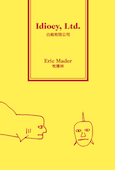
Remember Jack and "all work and no play"? The following trailer kind of reminds me of Fox News reporting during the Bush years. The difference being that whoever did this is brilliant--spin as a high art:
Sunday, April 17, 2011
Shining: The Trailer
Friday, April 15, 2011
Ideal Libraries (ZEI's Tuesday Mythology Class)
For some months our Tuesday night class has been reading chapters from Ursula K. LeGuin's Changing Planes. At the beginning of her chapter "Woeful Tales from Mahigul," the narrator describes Mahigul's Imperial Library, which I take to be a portrait of the writer's own ideal library. After reading this opening part of the chapter, I told my brilliant group of Tuesday students to write descriptions of their own ideal libraries for homework. Here are some of them:
Michelle writes:
My ideal study room should be without my brother, since he's noisy. With him taken care of, we can talk about the decoration and devices in the room. There should be enough light (not light bulbs in the morning, but sunlight) because warm sunlight through the window always makes me feel calm and soothes any headache that might be caused by math problems. Also good music would play an important part, as music gives me a good mood to study boring subjects like math or physics. And then, to mention something that is important but that could hardly happen in a city such as Taipei: a good view when I look out the window. I know it would cost an arm and a leg to realize this dream, since Taipei is a crowded city and urban land prices are always high. A good view, including a big space with trees and flowers or a blue sea or bright sky, can give my eyes a rest after a tiring war against Chinese, math . . . all the school subjects and assignments our teachers had given. Hmm. In any case, this is my "ideal room," so never mind about money. Without this factor of money, I think I could get my ideal study room some day. Maybe in the distant future?
Jenny Huang writes:
The library is called "Magic Library." Everyone in the library carries a book with them, a book to which you can pose any question about the library. The lights in the library are like stars, shining and beautiful. The book can fly anywhere, and tell you its stories. Like the universe, the library is dark, but you can read the book clearly. There is also a ball in which you can seat yourself. You can use the ball to fly anywhere you want. Inside it you can also eat anything you want. The book everyone carries is somewhat like the Internet--it can also find any information you need, all you have to do is think about it. It is really an interesting library, to which all are welcome. But think before you enter. Because many people enter, but never leave, like the "Hotel California."
Schani Lin writes:
My ideal study room will be in a quiet forest. It's a two-storied building, and my study room will be on the second floor. Sunlight enters through the glass ceiling which can put me in a good mood to study boring subjects. A balcony is outside the room. When I get tired, I'll go there to breathe some fresh air. If there's a hard problem in math or science, I'll go to the garden to take a walk and think of the solution. Quiet also plays an important role in my study room. When it's quiet, I can think of more things, be more creative and come up with better ideas. I hope one day I'll have my ideal study room for real.
Sherry Chen writes:
Press ENTER on the remote control and in a few seconds a book flies to you. You don't have to walk around to choose a book to match your taste: in this library, books fly to you without your touching them. YOUR MIND IS TELLING THE LIBRARY DIRECTLY WHICH BOOK IS THE BEST FOR YOU!
It's the biggest library in the world because you can call for a book any time or anywhere, you don't have to go to a building to borrow books or give them back--they'll fly.
All the books are housed in an island called "Holy Library." It's a fantastic place for readers. You can read in the mountains, at the beach, or even on a dolphin or in a big clam shell in the sea. All the books are stored in a cave with many entry and exit holes that allow them to fly in and out.
But the most special and praiseworthy part of the library is that you can dream the book you want. Push ADVENTURE on the remote control and it will give you two wires. Put the wires to your temples and what you get is not just a story in words, but an adventure. You can be any character in this story, and in this dream mode, you experience directly what is in the character's mind. You might be a hero, a vampire, a piece of ear wax, an amber or a mosquito.
For readers in the "Holy Library," books are power, words are magic. They travel through them, learn from them. Will you choose ENTER or ADVENTURE? Will you accept what your mind needs? Are you a strong enough reader for this library?
Lillian Huang writes:
In the future, nobody will have to go to the library, because people will already have their own library at their fingertips.
Once you pick up iPad10, it will be hard to put down. That's the idea behind all new design--thinner, lighter, the best for students.
1) Thinner and lighter
It's 50% thinner and lighter, so it feels even more comfortable in your hands. It makes surfing the web, playing games, listening to music, checking the mail, reading, writing . . . all so natural that you might forget there's incredible technology under your fingers.
2) High resolution
Download books from your iPad10 and you will be even more well-read. Full-page illustrated science books, art books, novels--everything is gripping on the beautiful, high-resolution iPad display.
3) LED backlighting
LED backlighting makes everything you see remarkable crisp, vivid, and bright.
4) Print everything wirelessly
With just a few taps, you can go from viewing something on the iPad screen to holding a printed copy.
Besides all this, with most books in the iPad library, you can change the text size or jump to any chapter right from the table of contents, and you can use bookmarks to make notes.
It's perfect for students.
(This is not an Apple ad--just my imagination.)
Monday, April 4, 2011
JS Porter, Thomas Merton, Ludicity
I've just today finished reading Canadian critic JS Porter's Thomas Merton: Hermit at the Heart of Things. The book will very likely make a Merton enthusiast of me. His writing here, as in Spirit Book Word, is infectious in its balance and intimacy. Porter is a great case study in the wisdom of only writing on what one cares about. The feel for Merton's predicament and character comes through better than it ever could had he followed a standard biographical format.
I'm guessing, when I do my next Amazon order, that I'll go for some of the Merton poetry and translations, and also for some of the political writings. Porter is especially taken with very late Merton, the great synthesist and student of Zen continuing to practice his omnivorous journaling to the end. I'm probably going to be more taken with middle Merton, especially the poet and political essayist. The correspondence with poet Robert Lax looks especially interesting in any case.
In any case, Merton, is on the reading list.
Aside from being a Trappist monk, poet, translator, and political activist, Merton was also an artist. One of the passages in Porter's book that struck me is from a letter Merton wrote to Lax regarding his "calligraphies":
Me and Ad Reinhardt [F] have been carrying on correspondence by obscure telepathies and hidden calligraphic paintings of which I must tell Charlie I got ten million. I make the fastest calligraphic paintings in the world, twenty nine a second, zip zip zip all over Kentucky they fly in the air the doves bear them away to no galleries. My art is pure I tell you it is pure. Like I said got swarms of calligraphies the only thing wrong with them says Ad is they too small, only about a foot long, real calligraphies got to be so vast you can't get them out of the building. (87)This approaches a tonal register I love, that same kind of light and ludicrous impertinence that is so effective in Gabriel Gudding or Max Jacob. Though not a fan of either nonsense verse or surrealist automatic writing--not at all--I'm very interested in writing, usually prose, that is slipping toward nonsense. What is needed in such writing is not the all-out automatism of the surrealists, but rather a subtler dose of automatism, just enough to effect that slippage toward the border. There is in this register a flat earnestness that is also somehow childlike, naive, ridiculously pedantic in its reverent irreverence. Merton is onto this in his letter to Lax.
If asked why I think such writing important, I'd have to say it's because it's just this mode that shows us most clearly what we are always in any case doing when we use language: we're making impertinently confident truth claims, spouting like children who've only grasped a corner of the Truth but somehow think they're qualified to teach others (usually smaller children) in the ways of the world.
Did the monk employ such studied ludicity elsewhere or only in correspondence with Lax?
[Some of my remarks above were adapted from a letter to Porter.]
Get JS Porter's Hermit at the Heart of Things through Amazon.com


